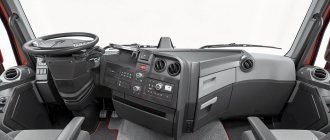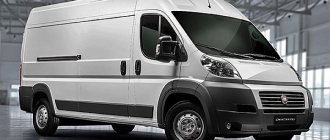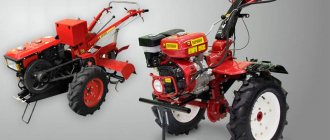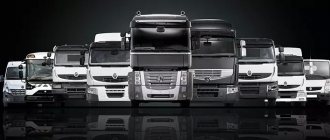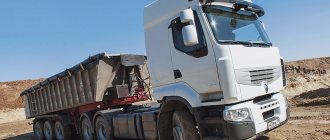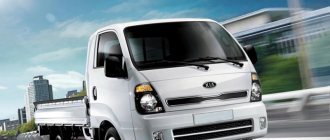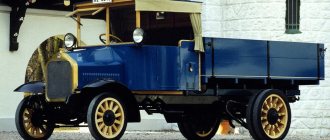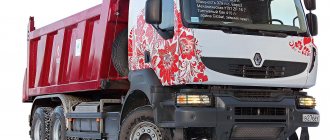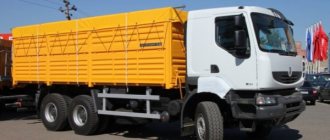| Renault Maxity | |
| Review | |
| Manufacturer | Nissan |
| Production | 2007-present |
| Assembly | Spain: Avila |
| Body and chassis | |
| Class | Truck |
| Body type | Truck (regular cab) |
| Connected | Nissan Cabstar Nissan Atlas |
| Transmission | |
| Engine | Diesel 2.5 3.0 I4 |
| Transmission of infection | 5-speed manual 6-speed manual |
| dimensions | |
| Length | From 2651 mm to 4961 mm |
| Width | 1870 mm |
| Chronology | |
| Predecessor | Renault Mascott |
The Renault Maxity
is a light commercial vehicle with a cab over engine and a stylish truck released by the French manufacturer Renault Trucks in 2007.[1] The Maxity is almost identical to the Nissan Cabstar, with the same transmission and engine options and manufactured at the same Nissan production line in Avila, Spain.[2] Although engine and production sharing is part of the Renault-Nissan Alliance, the vehicle is sold by Volvo-owned Renault Trucks.[3]
Characteristics
In Europe, the Maxity is available in 2.8 to 4.5 tonne versions, but only in 3.4 or 3.5 tonne versions in the UK.[4] The Maxity is rear-wheel drive and comes with one of two diesel engines; 2.5-liter DXi2.5 with a tuned power of 110 hp. (82 kW; 112 hp) and 130 hp (97 kW; 132 hp), as well as a 3.0-liter turbocharged DXi3 with 150 hp. (112 kW; 152 hp). All are mated to a five-speed or six-speed manual transmission depending on specification.
In 2010, Renault Trucks trialled an electric version with a 2-ton payload capacity in Paris with a drinks distributor. Tafanel.[5] The prototype truck was developed in collaboration with an electric vehicle manufacturer. PVI.[6]
The Maxity's compact dimensions are being promoted by Renault Trucks to emphasize use in cities and towns, with a cab width of 1,870 mm (73.6 in) and lengths ranging from 2,651 mm (104.4 in) to 4,961 mm (195.3 in) depending on configurations and a compact turning radius of 4.8 m (189.0 in).
Characteristics of Renault Maxity
Description of the Renault Maxity car
The debut show of the Renault Maxity truck took place in 2007. This model fits perfectly into urban operating conditions; thanks to its relatively small size, this machine moves without difficulty along narrow streets, easily maneuvers in heavy traffic, and is fuel efficient. To these advantages should be added high functionality and versatility. On the basis of a truck, you can assemble a van, tow truck and other types of special vehicles.
The appearance of the car is distinguished by large blocks of frontal light; the cabin has a significant glass area. The seats installed in the cabin offer an excellent view of the road, and the driver's workplace is organized at a high level. Air conditioning ducts are distributed along the front panel, controls for on-board systems are located under the driver’s hands, and if such a need arises, additional equipment can be mounted on the console.
Exterior
Renault's A-pillars are given a slight angle of inclination, the bow of the Maxity is flat, its side surfaces are completely occupied by large vertical headlight blocks that combine turn signals. A compact elongated pentagonal radiator grille extends between the headlights; its interior space is filled with polymer, narrow horizontal slats. The narrow bumper is made of polymer and has a decorative overlay applied to it. The rear window of the cabin is covered with a protective body kit, the low sides can be fully tilted, and the brake lights are mounted on metal brackets mounted under the side. The overall dimensions of the body are 6673/1870/2135 mm, the wheel track ratio is 1569/1492 mm. The wheelbase is 2500 mm, the total weight is 3500 mm, the curb weight is 1820 mm, the full turning circle is 10.6 meters.
Interior
Highly installed Renault seats provide clearly noticeable lateral and popliteal support; in front of the Maxity front passenger seat, a spacious niche is made on the front panel, and a shelf is formed that can accommodate a stack of A4 documents. A massive, square-shaped console block protrudes from the center of the panel; it is equipped with air ducts, air conditioning controls, and several control keys for service systems. Cup holders are suspended under the console, and even lower there is a niche, adjacent to which is a high platform with a transmission selector. The rectangular instrument panel is equipped with three scales framed by decorative inserts.
Specifications
Renault Maxiti is powered by a 150-horsepower turbocharged diesel engine. It has a displacement of 2953 cm3, develops a maximum torque of 350 Nm, a cruising speed of 135 km/h, and an average fuel consumption of 12.5 liters.
References
- Commercialmotor.com August 20, 2007
- Which Van? February 23, 2007
- Nissan Press Release November 2, 2006
- Transport news Archived July 23, 2010 Wayback Machine
- “RENAULT TRUCKS INTRODUCES TAFANEL KEYS TO THE FIRST ZERO-EMISSION MAXITY ELECTRIC VEHICLE.” Press release from Renault Truck. May 12, 2010. Retrieved August 8, 2013.
- “Electric vehicles deliver the goods.” Engineer. May 24, 2010. Retrieved August 8, 2013.
“I freaked out and bought a new car”
– I had a Laguna 2, I drove it for a long time and did not bother, but then it began to actively break down. It all started when a corrugation ruptured, I overcooked it, drove it for a week, and the exhaust manifold ruptured. It turned out that the catalyst was clogged. I freaked out and bought a new car.
Two weeks before the purchase, a friend and I went to the market, and I saw the Grand Scenic IV, which I was very impressed with. I had already seen the Espace V before, but I didn’t really like it for its body shape. In general, initially I wanted Talisman, but after sitting in Scenic, I realized that I liked it more. The functionality is the same, it’s more spacious inside.
The 2022 model car was purchased on the car market in June 2020. The price listed on the Internet was 15,350 dollars, on the front-line market it was 15,950, and I just came and said: “Here’s 14 thousand - I’ll take it.” I justified my amount by investing in the purchase of new tires, since they were worn out, brake discs and pads, changing the oil, filters, liners and timing belt. The seller said: “Ok, 14.300 - and take it.” We agreed on this. Yes, during the negotiations I went to carVertical, paid for the service and checked the car's history using the VIN. It turned out that the last service in the Netherlands was at 200 thousand, and the dashboard showed 120 thousand. This also became a bargaining point.
The same thing was later confirmed by the official dealer, to whom I went to do the first major maintenance. Considering that the last time the car was serviced in Europe was in February 2020, and in Belarus it was cleared through customs at the end of March, then I think that exactly 100 thousand were lost.
“I don’t like the cost of tires”
I don't like the cost of tires. Yes, the car looks great on 20's wheels, but you have to spend money on tires. Although these are one-time expenses for several years in advance.
Many people disable the automatic activation of the electric parking brake when the transmission is shifted into park, but it does not bother me at all. Likewise, I have no plans to programmatically deactivate the Start/Stop system just yet. I just made it a rule to turn it off with a button after starting the engine. As a transport operation engineer, I think this function is harmful - it’s better to burn a little extra diesel fuel. And what kind of fuel economy is there - 200 grams per 100 kilometers? By the way, my average consumption in mixed mode is 7.5 liters per 100 kilometers. But I also travel quite actively.
I want to update the maps in the near future, since the ones we have now do not recognize all addresses.
The Grand Scenic IV is a joy to drive. I’m not going to sell the car, although with today’s prices it would easily go for 16 thousand. A very comfortable car - I recommend it to everyone.
“I would like the engine to be more powerful”
I like everything about the car, but I would like a more powerful engine. One and a half liter is enough in most modes, but sometimes there are situations when you need more dynamics.
The equipment here is good, but not the richest. There is a panoramic roof, I used it a couple of times in cloudy weather or at dusk - it makes the car lighter. In hot summers it is useless.
Ideally, I would like to have control of “dead” spots, although with such size mirrors it is not really needed, and adaptive cruise control, and a rear view camera, and all-round parking sensors with auto parking.
By the way, despite the absence of a radar, the car, apparently, based on data from the camera, recognizes the approach to the car in front and slows down itself.
The front seats are very comfortable and have built-in massage. But I used it once.
My car is a five-seater. There are many seven-seat versions on sale, but I don't need two extra seats. Much more important is a spacious trunk.
It has roomy space under the floor, and a subwoofer is hidden even lower - the “music” in a Bose car, it sounds cool. True, I want to buy a spare wheel in which I can hide the sub, since the standard kit only included a repair kit with sealant.
An interesting feature of keyless entry: when you approach the car with the key in your pocket, the lamps located below in the mirrors turn on. It's very convenient at night.
I really like the light of LED headlights - driving at night is a pleasure. Turn on the light - and you don’t have to think about when to switch from low beam to high beam. When an oncoming car approaches, the focus of the light beam changes, which allows you to avoid blinding drivers.
“The first major maintenance cost 1,500 rubles”
At the first service, the dealer connected the computer - and did not find any problems. Even the particulate filter showed three grams of soot. In June of this year they checked again - the number increased to seven.
Also, after the purchase, we checked such a parameter as mileage in seventh gear. On a car with a robotic transmission, it is fixed separately. So, in seventh gear my car covered 100 thousand kilometers. That is, half of her trips, if not more, were on the highway. The body shop inspected the paint and found no problems, except for a polished area on the trunk lid. Perhaps they were removing some kind of scratch.
By the way, about the gearbox. I was purposefully looking for a car with an automatic transmission and knew very well that the Scenic IV had a “robot”. I read the Internet, asked people around and decided that there was nothing wrong with it. And now I don’t regret my choice one bit. It works clearly and switches quickly. Yes, and replacing a clutch with a dual-mass flywheel on a “mechanical” one costs under a thousand dollars - about the same amount it will cost to repair a “robot” when it is needed.
The first major maintenance from the “officials” included the replacement of a timing belt kit with a pump, belts, antifreeze, oil, liners and all filters. All this cost me 1,500 rubles. The only thing that had to be changed separately later was the oil in the “robot”. The necessary oil was simply not available in Belarus; I had to buy it in Poland. 4 liters cost exactly $100 with delivery to the Republic of Belarus, and replacement work cost 40 rubles.
Further maintenance essentially boiled down to changing oil and filters every 10 thousand.

